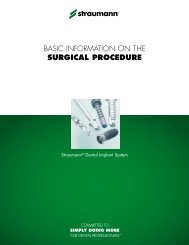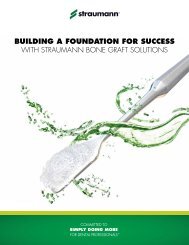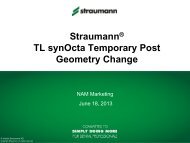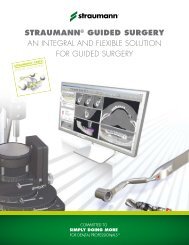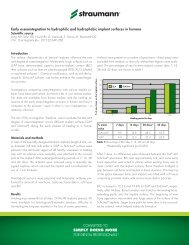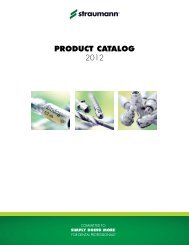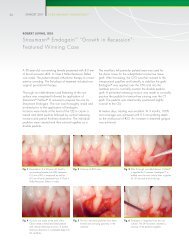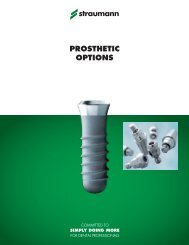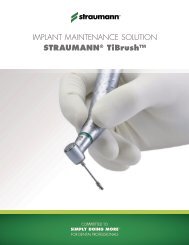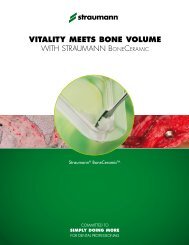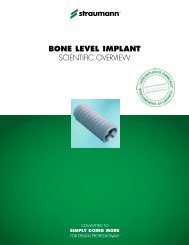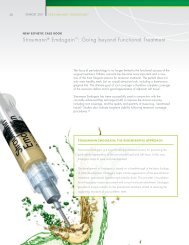Implant Selection Guide - Straumann
Implant Selection Guide - Straumann
Implant Selection Guide - Straumann
Create successful ePaper yourself
Turn your PDF publications into a flip-book with our unique Google optimized e-Paper software.
STRAUMANN's IMPLANT PORTFOLIO<br />
The <strong>Straumann</strong> ® Dental <strong>Implant</strong> System offers four implant lines with diverse body and neck designs ranging from the classic soft tissue<br />
level to the bone level implant. All implants can be placed with one surgical kit and use similar surgical procedures.<br />
2.8 mm<br />
1.8 mm<br />
Standard<br />
(S)<br />
Standard Plus<br />
(SP)<br />
Tapered Effect<br />
(TE)<br />
Bone Level<br />
(BL)<br />
Standard<br />
Classic soft tissue level implant<br />
Standard Plus<br />
For flexible placement<br />
Tapered Effect<br />
For immediate placement<br />
Bone Level<br />
Expertise at bone level<br />
<strong>Straumann</strong> ® Standard implants<br />
feature a smooth neck section<br />
of 2.8 mm in height and are<br />
particularly well-suited for<br />
single-stage procedures, where<br />
the implant is placed at the soft<br />
tissue level and not covered<br />
with the soft tissue during the<br />
healing phase.<br />
<strong>Straumann</strong> ® Standard Plus<br />
implants consist of a smooth<br />
neck section of 1.8 mm in<br />
height that allows flexible<br />
coronoapical implant placement<br />
in combination with transor<br />
subgingival healing.<br />
<strong>Straumann</strong> ® Tapered Effect<br />
implants have a special<br />
anatomical design, which<br />
combines a cylindrical shape in<br />
its apical region and a conical<br />
shape in the coronal region,<br />
making this implant particularly<br />
suitable for immediate or early<br />
implantation following extraction<br />
or loss of natural teeth.<br />
<strong>Straumann</strong> ® Bone Level implants<br />
are suitable for bone level<br />
treatments in combination with<br />
trans- or subgingival healing. The<br />
implant’s rough surface extends<br />
to the top of the implant and the<br />
connection is shifted inwards. The<br />
selection of healing components<br />
and temporary abutments available<br />
for the Bone Level implant are used<br />
to shape the soft tissues above the<br />
top of the implant, which is flush<br />
with the crestal bone.<br />
<strong>Straumann</strong>’s Tradition of Innovation<br />
<strong>Straumann</strong> is the pioneer of innovative solutions for implant dentistry, including the introduction of the SLA ® surface in 1994,<br />
the revolutionary SLActive ® surface in 2006, and the technologically-advanced Roxolid ® implant material in 2009.<br />
SLA implant surface<br />
With unique characteristics<br />
such as double roughness<br />
treatment for greater bone-toimplant<br />
contact, the SLA surface<br />
is designed to allow loading<br />
in just six weeks after implant<br />
placement in healthy patients<br />
with sufficient bone quality and<br />
quantity.<br />
SLAc t i v e implant surface<br />
The SLActive surface takes the<br />
topography of the SLA surface<br />
to the next level through its<br />
enhanced surface chemistry.<br />
With the unique properties of<br />
hydrophilicity and chemical<br />
activity, SLActive accelerates<br />
the osseointegration process,<br />
allowing for shorter healing<br />
times of 3-4 weeks in<br />
appropriate clinical<br />
circumstances.*<br />
Roxolid implant material<br />
Roxolid is the first Titanium Zirconium alloy<br />
developed specifically for the needs of<br />
dental implantology. This unique material<br />
has higher tensile strength than pure titanium.<br />
Roxolid features higher fatigue strength<br />
and osseointegration when compared<br />
to <strong>Straumann</strong> SLActive titanium implants.<br />
Roxolid is available for <strong>Straumann</strong> implants<br />
with an endosseous diameter of 3.3 mm<br />
except NN, and offers greater confidence<br />
when placing small diameter implants.<br />
*compared to SLA in an animal model



